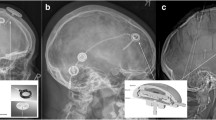Abstract
Several studies have demonstrated lowered cerebral blood flow (CBF) in patients with hydrocephalus and symptoms of raised intracranial pressure. Ventricular shunting in such cases permits a sudden increase in CBF. The pathophysiology of functional brain deficit secondary to hydrocephalus is little understood. Improvement of the patient's clinical status after drainage of CSF suggests that cerebral dysfunction is not necessarily due to permanent brain damage. In fact, it improves rapidly after ventricular taps. In view of this it would be helpful to monitor cerebral perfusion. The transcranial Doppler (TCD) ultrasonography technique allows real-time monitoring of the intracranial circulation and makes it possible to evaluate the physiopathological correlation between ventricular dilatation and CBF. Continuous monitoring of the middle cerebral artery (MCA) by TCD was performed in three hydrocephalic children (2 months, 14 months, and 8 years old) during a ventricular-peritoneal shunt operative procedure. A TC-2000S device provided by an IMP-F fixed probe was utilized. In all patients, when the lateral ventricle was shunted and the CSF could flow away, a clear and sudden increase of flow velocity above 30% was detected. The pulsatility index (PI) was also pathologically increased in all patients. A gradual normalization of this index was revealed after the shunting procedure. Our experience has to be considered preliminary, but nonetheless, it suggests a clear correlation between hydrocephalic disease and concomitant CBF alterations. A more consistent number of monitoring performances by TCD during operative procedures will improve our understanding of the role of CBF in the development of functional deficits in hydrocephalic disease.
Similar content being viewed by others
References
Aaslid R, Markwalder TM, Nornes H (1982) Noninvasive transcranial Doppler ultrasound of flow velocity in basal cerebral arteries. J Neurosurg 57: 769–774
Adams RJ, Nichols FT, Hess DC (1992) Normal values and physiological variables. In: Newell DW, Aaslid R (eds) Transcranial Doppler. Raven Press, New York, pp 41–48
Archer LNJ, Evans DH, Patton JY, Levene MI (1986) Controlled hypercapnia and neonatal cerebral artery Doppler ultrasound waveforms. Pediatr Res 20: 218–221
Bada HS, Hajjar W, Chua C, Sumner DS (1979) Non-invasive diagnosis of neonatal asphyxia and intraventricular haemorrhage by Doppler ultrasound. J Pediatr 95: 775–779
Davson H, Welch K, Segal MB (1987) General features of hydrocephalus. In: Davson H, Welch K, Segal MB (eds) The physiology and pathophysiology of the cerebrospinal fluid. Churchill Livingstone, Edinburgh London Melbourne, pp 783–805
Del Bigio MR, Bruni JE (1988) Changes in periventricular vasculature of rabbit brain following induction of hydrocephalus and after shunting. J Neurosurg 69: 115–120
Finn JP, Quinn MW, Hall-Craggs MA, Kendall BE (1990) Impact of vessel distortion on transcranial Doppler velocity measurements: correlation with magnetic resonance imaging. J Neurosurg 73: 572–575
Fujioka KA, Douville CM (1992) Anatomy and freehand examination techniques. In: Newell DW, Aaslid R (eds) Transcranial Doppler. Raven Press, New York, pp 9–31
Kirsch JR, Traystman RJ, Rogers MC (1985) Cerebral blood flow measurements techniques in infants and children. Pediatrics 75: 887–894
Plets C (1986) Influence of experimental hydrocephalus on cerebral vascularization. In: Baethmann A, Go KG, Unterberg A (eds) Mechanisms of secondary brain damage. Plenum Press, New York, pp 169–178
Pourcelot L (1975) Applications cliniques de l'examen Doppler transcutane. In: Peronneau P (ed) Velociniertre ultrasonne Doppler. Institut National de la Santé et de la Recherche Médicale, Paris, pp 213–240
Shapiro K, Fried A, Marmarou A (1985) Biomechanical and hydrodynamic characterization of the hydrocephalic infant. J Neurosurg 63: 69–75
Sorteberg W (1992) Cerebral artery blood velocity and cerebral blood flow. In: Newell DW, Aaslid R (eds) Transcranial Doppler. Raven Press, New York, pp 57–66
Steiger HJ (1992) Monitoring for carotid surgery. In: Newell DW, Aaslid R (eds) Transcranial Doppler. Raven Press, New York, pp 197–205
Vostrup S, Christensen J, Gjerris F, et al (1987) Cerebral blood flow in patients with normal-pressure hydrocephalus before and after shunting. J Neurosurg 66: 379–387
Wikkelso C, Andersson H, Blomstrand C, et al (1986) Normal pressure hydrocephalus. Predictive value of the cerebrospinal fluid tap-test. Acta Neurol Scand 73: 566–573
Wozniak M, McLone DG, Raimondi AJ (1975) Micro- and macrovascular changes as the direct cause of parenchymal destruction in congenital murine hydrocephalus. J Neurosurg 43: 535–545
Author information
Authors and Affiliations
Rights and permissions
About this article
Cite this article
Iacopino, D.G., Zaccone, C., Molina, D. et al. Intraoperative monitoring of cerebral blood flow during ventricular shunting in hydrocephalic pediatric patients. Child's Nerv Syst 11, 483–486 (1995). https://doi.org/10.1007/BF00334971
Issue Date:
DOI: https://doi.org/10.1007/BF00334971




